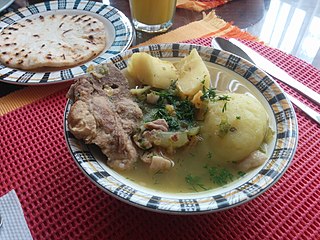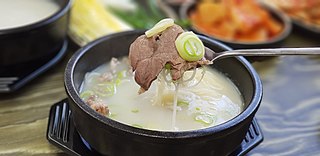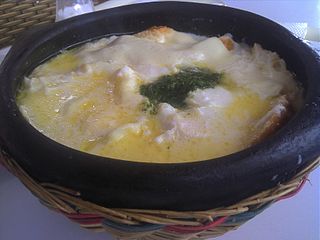
Tripe is a type of edible lining from the stomachs of various farm animals. Most tripe is from cattle, pigs and sheep.

Santander is a department of Colombia. Santander inherited the name of one of the nine original states of the United States of Colombia. It is located in the central northern part of the country, borders the Magdalena River to the east, Boyacá to the south and southeast, the Norte de Santander Department to the northeast, the Cesar Department to the north, the Bolivar and Antioquia Departments to the west. Its capital is the city of Bucaramanga.

Tripe soup or tripe stew is a soup or stew made with tripe. It is widely considered to be a hangover remedy.
Serbian cuisine is a Balkan cuisine that consists of the culinary methods and traditions of Serbia. Its roots lie in Serbian history, including centuries of cultural contact and influence with the Greeks and the Byzantine Empire, the Ottomans, and Serbia's Balkan neighbours, especially during the existence of Yugoslavia. Historically, Serbian food develops from pastoral customs that involved the keeping of sheep in mountain highlands, in a climate and regional context that favoured animal husbandry over vegetable farming; Serbian food is therefore traditionally richer in animal products and basic grains—corn, wheat and oats—than fresh vegetable dishes. Following the abandonment of widely practiced pastoral lifestyles, Serbian food emerged through the Middle Ages heavily dependent not on lamb or mutton, but on the keeping of pigs for the annual cull and the production of various cured meats, such as sausages, bacon and ham products.

Sancocho is a traditional soup in several Latin American cuisines. Variations represent popular national dishes in Dominican Republic, Colombia, Cuba, Honduras, Ecuador, Panama, Puerto Rico, Trinidad and Tobago, and Venezuela. It usually consists of large pieces of meat, tubers and vegetables served in a broth.

Seolleongtang (설렁탕) or ox bone soup is a Korean broth tang (soup) made from ox bones, brisket and other cuts. Seasoning is generally done at the table according to personal taste by adding salt, ground black pepper, red pepper, minced garlic, or chopped spring onions. It is a local dish of Seoul.
Canarian cuisine refers to the typical dishes and ingredients in the cuisine of the Canary Islands, and it constitutes an important element in the culture of its inhabitants. Its main features are the freshness, variety, simplicity, and richness of its ingredients, the mix of seafood and meat dishes, its cultural influences and the low knowledge of it by the rest of the world. Canarian cuisine is influenced by other cultures, especially that of the aboriginal inhabitants of the islands (Guanches), and has influenced Latin American cuisine.

Colombian cuisine is a compound of the culinary traditions of the six main regions within Colombia. Colombian cuisine varies regionally and is particularly influenced by Indigenous Colombian, Spanish, and African cuisines, with slight Arab influence in some regions. Furthermore, being one of the most biodiverse countries in the world, Colombia has one of the widest variety of available ingredients depending on the region.

Changua is a typical hearty breakfast soup of the central Andes region of Colombia, in particular in the Boyacá and Cundinamarca area, including the capital, Bogotá. It also has a reputation as a hangover cure, being a popular late night meal.

Haejang-guk or hangover soup refers to every kind of guk or soup eaten as a hangover cure in Korean cuisine. It means "soup to chase a hangover" and is also called sulguk. It usually consists of dried napa cabbage, vegetables and meat in a hearty beef broth. One type of haejangguk, seonjiguk, includes sliced congealed ox blood and another type, sundaeguk, includes a kind of blood sausage made with intestine stuffed with pig's blood and other ingredients.

Most traditional foods in Guatemalan cuisine are based on Maya cuisine, with Spanish influence, and prominently feature corn, chilies and beans as key ingredients. Guatemala is famously home to the Hass avocado.

Soup is a primarily liquid food, generally served warm or hot, that is made by combining ingredients of meat or vegetables with stock, milk, or water. Hot soups are additionally characterized by boiling solid ingredients in liquids in a pot until the flavors are extracted, forming a broth. Soups are similar to stews, and in some cases there may not be a clear distinction between the two; however, soups generally have more liquid (broth) than stews.

Galbi-tang or short rib soup is a variety of guk, or Korean soup, made primarily from beef short ribs along with stewing beef, radish, onions, and other ingredients. The short ribs, or "galbi",also refers to grilled short ribs in Korean barbecue while the suffix tang is another name for guk. Hence, the Korean name literally means "short ribs soup" and is also called garitang, or galitang. The clear and hearty soup is made by slowly simmering galbi in water for a long time and is eaten as a meal. It is similar to seolleongtang, a soup made from the bones of ox legs.

Puchero is a type of stew originally from Spain, prepared in Yucatán, Mexico, Argentina, Paraguay, Uruguay, Perú, south of Brazil, the Philippines, and Spain, specifically the autonomous communities of Andalusia and the Canary Islands. The Spanish word "puchero" originally meant an earthenware pot, before being extended to mean any vessel, and then the dish cooked in it.

Plantain soup is eaten in various cuisines. In Colombian cuisine, the dish is known as sopa de patacón. There is also sopa de platanos in Latin American cuisine including Cuban cuisine and Puerto Rican cuisine.

Hangover remedies consist of foods, dishes, and medicines, that have been described as having a theoretical potential for easing or alleviating symptoms associated with the hangover.

Fricasé is a traditional soup in Bolivian cuisine prepared with pork, pork ribs or chicken, hominy, chuño or potatoes, onion, garlic, salt, pepper and spices. It is sometimes consumed as a hangover food, as having a theoretical potential for easing or alleviating symptoms associated with the hangover.

Birrieria PDX is a Mexican restaurant in Portland, Oregon.
















